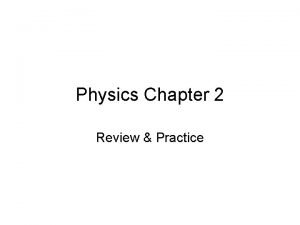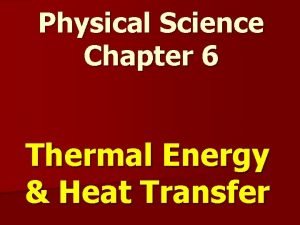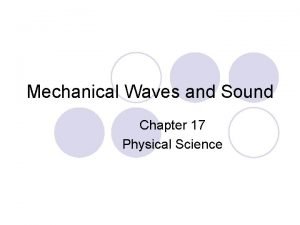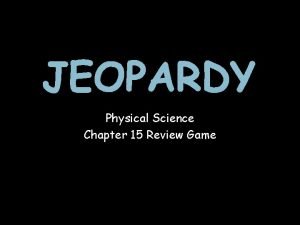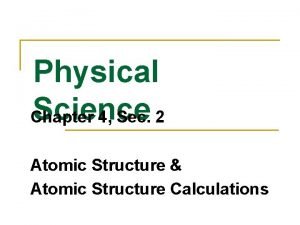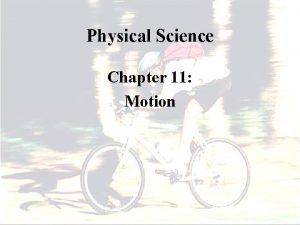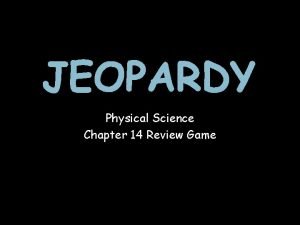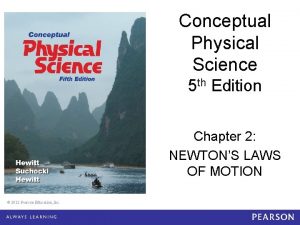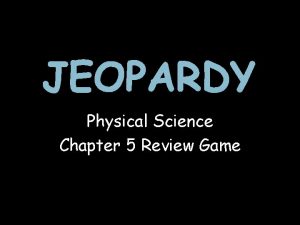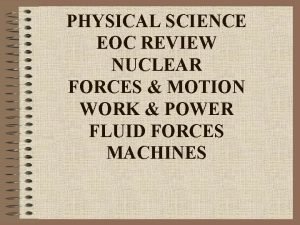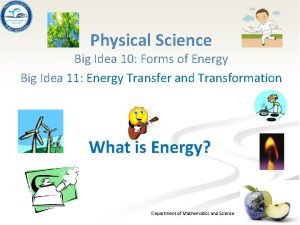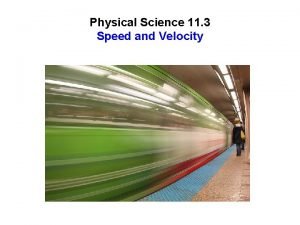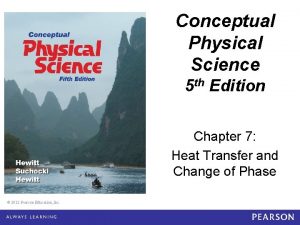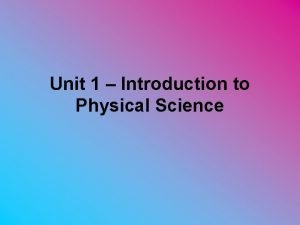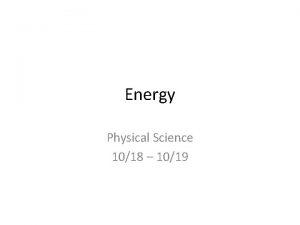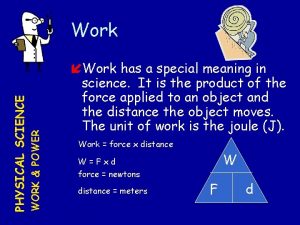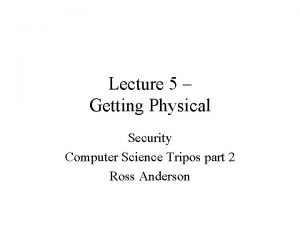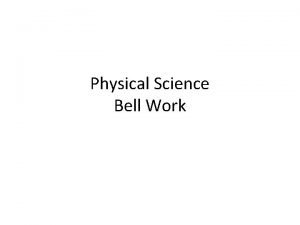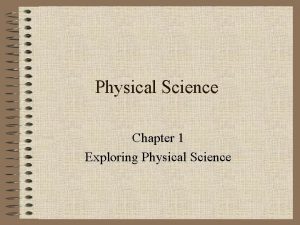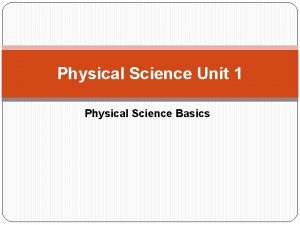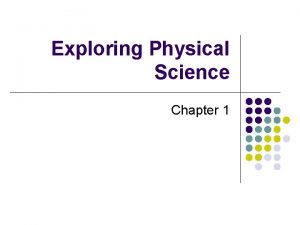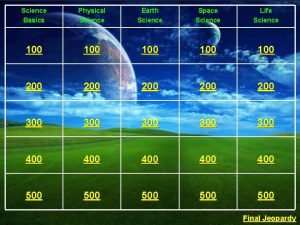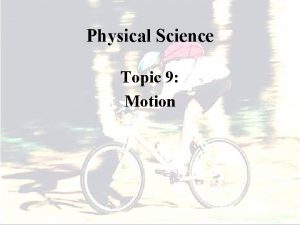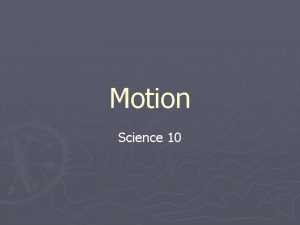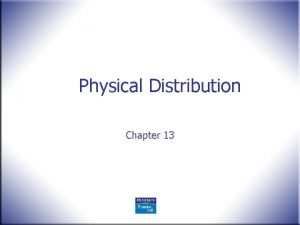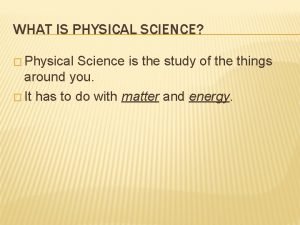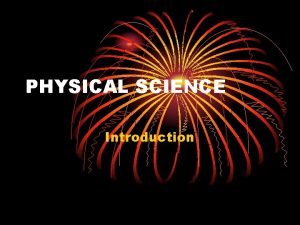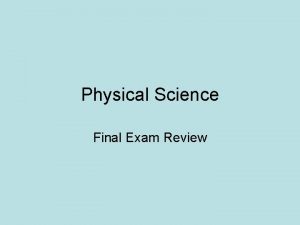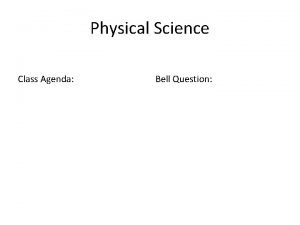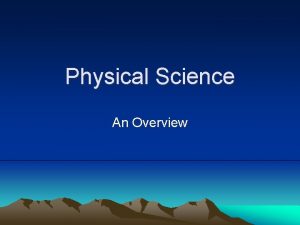Physical Science Chapter 11 Motion Motion v How


















































- Slides: 50

Physical Science Chapter 11: Motion

Motion v. How Important is Motion? v. How Do You Interpret Motion?

Motion v. All Kinds of Motion v. Perceiving motion is instinctive v. Your eyes pay more attention to moving objects than to stationary ones v. Movement is all around you v. Movement travels in many directions vstraight-lines vcurved paths vspirals vswirls

Motion v. All Kinds of Motion v. Frame of Reference v. How Motion is Perceived v. Relative Motion v. Moving Objects with Respect to One Another

Motion v. Picturing Motion v. Particle Model v. Constant Velocity v. Increasing Velocity v. Decreasing Velocity

Motion v. Coordinate System v. A coordinate system tells you the location of the zero point of the variable you are studying and the direction in which the values of the variable increase

Motion v. Coordinate System v. For Movement Along a Straight Line v. Coordinates Would Also be in a Straight Line vex. Number Line

Motion v. Coordinate System v. X – Y Coordinate v. Provides Origin v. The origin is the point at which both variables have the value zero v. Time and Position v. Position in Different Axis

Motion v. Coordinate System v. Origin v. The arrow shown in the figure represents the runner’s position, which is the separation between an object and the origin

Motion v. Coordinate System v. The length of the arrow shows how far an object is from the origin and indicates its distance from the origin v. A position 5 m left of the origin, would be a negative position

Motion v. Time Interval (Dt) v. Time Elapsed During Motion

Motion v. Displacement (d) v. The change in position during the time interval between ti and tf is called displacement

Motion v. Displacement (Dd) v. Displacement is equal to the final position minus the initial position

Motion v. Distance v. Length of the Path Between Two Points v. Scalar Quantity v. Displacement v. Length Between the Start Point and the End Point v. Vector Quantity

Motion v. Distance vs. Displacement

Motion v. Scalar and Vector Quantities v. Scalar Quantity v. Magnitude (number and units) vex. 15 km or 250 C v. Vector Quantity v. Magnitude and Direction vex. 15 km north or 9. 8 m/s 2 down

Motion v. Vectors v. Represented by Arrows v. Direction of the Arrow Represents the Direction of the Vector v. The Length of the Arrow is Proportional to the Magnitude of the Vector

Motion v. Problem v. Which of the following are vectors? v. Temperature v. Distance v. Displacement

Motion v. Solution v. Which of the following are vectors? v. Temperature (scalar) v. Distance (scalar) v. Displacement (vector)

Motion v. Resultant v. The vector that represents the sum of the other vectors is called the resultant v. The resultant always points from the tail of the first vector to the tip of the last vector

Motion v. Movement Along a Straight Line v. Motion relates to position and time. v. In the figure below, the car has moved from point A to point B in a specific time period.

Motion v. Picturing Motion v 100 m Dash vhttp: //www. youtube. com/watch? v=2 O 7 K 8 G 2 nw. U vhttp: //www. youtube. com/watch? v=o. EWq. Jm. Jut 0

Motion v. What Is Speed? v. What Is Velocity?

Motion v. Average Speed v. The absolute value of the slope of a position-time graph v. The sign of the slope tells you in what direction the object is moving v. Scalar Quantity

Motion v. Average Velocity v. The slope tells you in what direction the object is moving v. Vector Quantity

Motion v. Average Velocity v. Units v. Displacement – Unit of Distance v. Meter (m) v. Time v. Second (s) v. Velocity vm/s

Motion v. Average Velocity Using Displacement and Time d = change in displacement Average of Two Velocities

Motion v. Average Velocity v. Calculated Over a Period of Time

Motion v. Position – Time Graphs v. Information about an object’s position at various times v. Helpful in determining the displacement of an object during various time intervals

Motion v. Position – Time Graphs

Motion v. Position – Time Graphs

Motion v. Equivalent Representations v. All Contain the Same Information about an Object’s Motion

Motion v. Combining Velocities v. Velocity is a Vector v. Magnitude and Direction v. Vectors can be Added

Motion v. What Is Acceleration? v. What Do You Think of When You Think of Acceleration? v. What is it to Accelerate?

Motion v. Acceleration v. Gives You the “Feeling” of Being Pushed v. Change in Velocity over a Period of Time v. Compare v 0 Velocity v. Constant Velocity v. Increasing Velocity v. Decreasing Velocity

Motion v. Acceleration v. The Slope of a Velocity – Time Graph

Motion v. Acceleration v. Change in Velocity over a Period of Time

Motion v. Acceleration v. Units v. Velocity = m/s v. Time = Second v. Acceleration = m/s/s or m/s 2

Motion v. Negative Acceleration v. Acceleration can be Positive or Negative v. There is No Such Thing as Deceleration v. Negative acceleration means slowing down

Motion v. Graphing Acceleration

Motion v. Graphing Acceleration

Motion v. Graphing Acceleration

Motion v. Free Fall v. Acceleration Due to Gravity ONLY! v. Galileo concluded that, neglecting the effect of the air, all objects in free fall had the same acceleration. It didn’t matter what they were made of, how much they weighed, what height they were dropped from, or whether they were dropped or thrown.

Motion v. Free Fall v. The acceleration of falling objects, given a special symbol, g, is equal to 9. 80 m/s 2. v. The acceleration due to gravity is the acceleration of an object in free fall that results from the influence of Earth’s gravity only.

Motion v. Free Fall

Motion v. Free Fall v. At the top of the flight, the ball’s velocity is 0 m/s. What would happen if its acceleration were also zero? Then, the ball’s velocity would not be changing and would remain at 0 m/s.

Motion v. Free Fall v. If this were the case, the ball would not gain any downward velocity and would simply hover in the air at the top of its flight.

Motion v. Free Fall v. Because this is not the way objects tossed in the air behave on Earth, you know that the acceleration of an object at the top of its flight must not be zero. Further, because you know that the object will fall from that height, you know that the acceleration must be downward.

Motion v. Free Fall v. Amusement parks use the concept of free fall to design rides that give the riders the sensation of free fall. v. These types of rides usually consist of three parts: the ride to the top, momentary suspension, and the plunge downward. v. When the cars are in free fall, the most massive rider and the least massive rider will have the same acceleration

Motion v. Homework
 3 branches of science
3 branches of science Natural and physical science
Natural and physical science What is his favorite subject?
What is his favorite subject? Physrt
Physrt Chapter 6 physical science
Chapter 6 physical science A 120m long ski lift carries skiers
A 120m long ski lift carries skiers Chapter 17 mechanical waves and sound
Chapter 17 mechanical waves and sound Chapter 15 review physical science
Chapter 15 review physical science Physical science chapter 4 review
Physical science chapter 4 review Chapter 11 physical science
Chapter 11 physical science Chapter 14 review physical science
Chapter 14 review physical science Conceptual physical science practice sheet chapter 2
Conceptual physical science practice sheet chapter 2 Chapter 5 review physical science
Chapter 5 review physical science As your room gets messier day by day, entropy is
As your room gets messier day by day, entropy is Chapter 16 review physical science
Chapter 16 review physical science Chapter 2 motion section 1 describing motion answer key
Chapter 2 motion section 1 describing motion answer key Chapter 2 motion section 1 describing motion answer key
Chapter 2 motion section 1 describing motion answer key Motion section 1 describing motion
Motion section 1 describing motion Chemistry central science 14th edition
Chemistry central science 14th edition Representing motion physics answers chapter 2
Representing motion physics answers chapter 2 Rate fences services marketing
Rate fences services marketing Physical activity and physical fitness assessments grade 9
Physical activity and physical fitness assessments grade 9 Physical science anak usia dini
Physical science anak usia dini Physical science jeopardy
Physical science jeopardy Physical science final exam
Physical science final exam Physical science eoc study guide
Physical science eoc study guide Physical science eoc review
Physical science eoc review Section 4 review physical science
Section 4 review physical science Which is a “big idea” of physical science?
Which is a “big idea” of physical science? Physical science lecture notes
Physical science lecture notes Pearson physical science concepts in action answers
Pearson physical science concepts in action answers Physical science force
Physical science force Academic standards in physical science
Academic standards in physical science What is displacement in physical science
What is displacement in physical science Forms of energy
Forms of energy Velocity physical science
Velocity physical science Exploring physical science
Exploring physical science Waves notes pdf download
Waves notes pdf download Conceptual physical science 5th edition
Conceptual physical science 5th edition Microscopic slush in water tends
Microscopic slush in water tends Conceptual physical science 5th edition
Conceptual physical science 5th edition Lesson 1 thermal energy and the behavior of matter
Lesson 1 thermal energy and the behavior of matter Physical science scientific notation worksheet answers
Physical science scientific notation worksheet answers Testimonial evidence examples
Testimonial evidence examples Bacground
Bacground Physical science
Physical science Wxhwebsite
Wxhwebsite Physical science
Physical science Physical science 436
Physical science 436 Physical security computer science
Physical security computer science Physical science bell ringers
Physical science bell ringers



